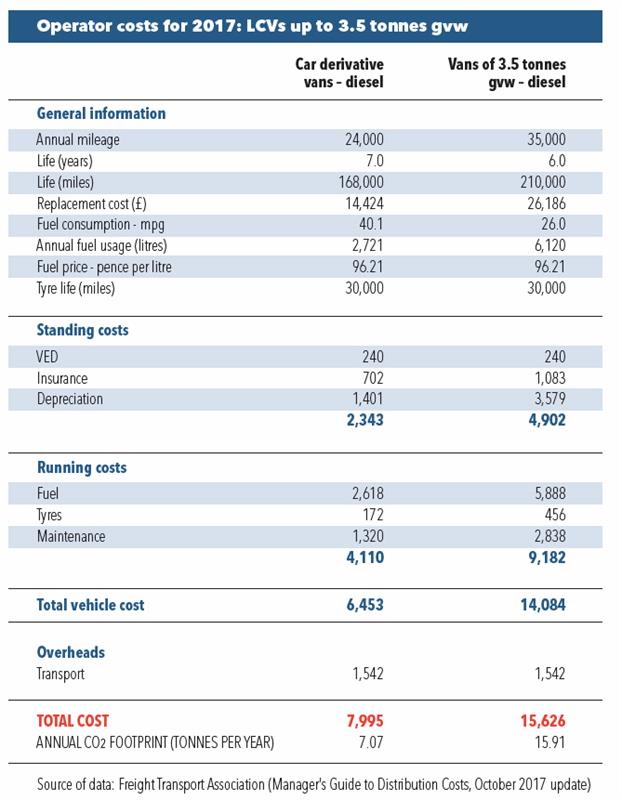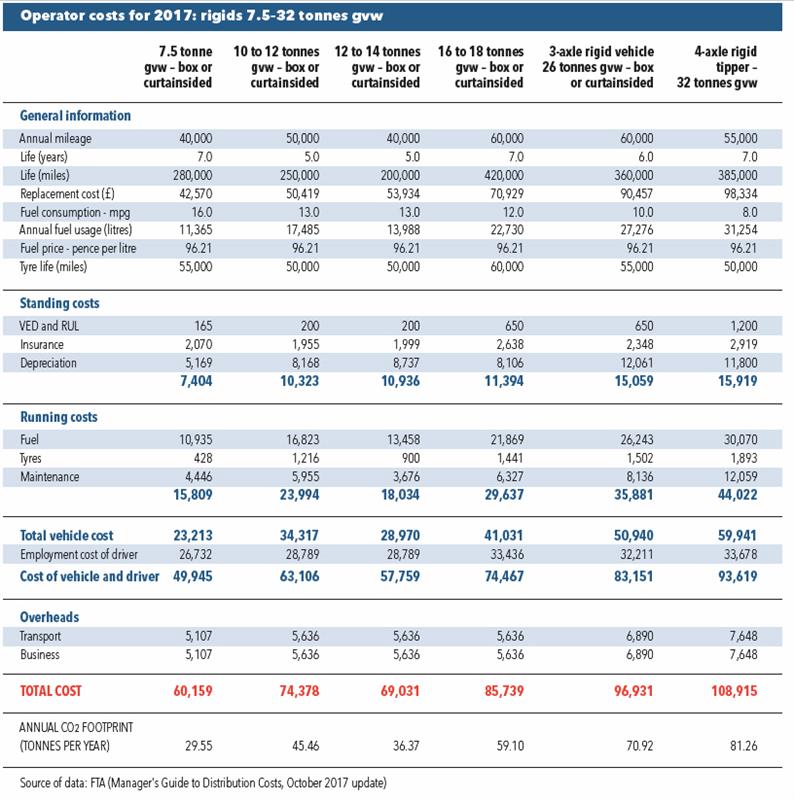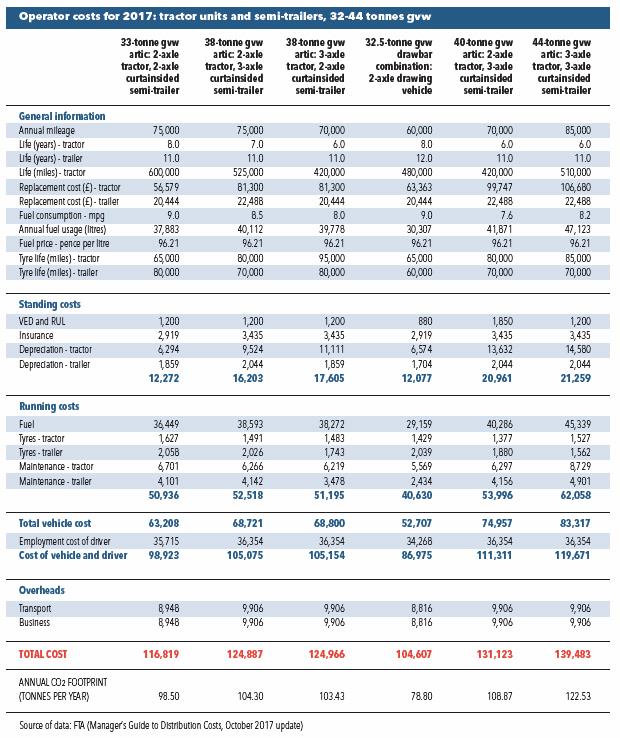After a tough 12 months for operators and the transport industry in 2016, life didn’t get much easier for operators last year. The process surrounding Brexit has dragged on – at the time of going to press in mid-December, talks had only just progressed into phase two, having overcome hurdles such as the Irish border and ‘divorce bill’ – and there is plenty more to do. A more pressing wider issue for the future is its impact on the UK’s economy, which has faltered, leading to revised growth targets, and increasing interest rate and inflation concerns.
In October 2016 the International Monetary Fund set a growth rate for Britain of 1.1% for 2017, before stronger-than-expected economic activity caused it to raise that forecast to 1.5% last January, and then to 2% three months later. However, by July, that prediction had been downgraded to 1.7%, following poor economic performance. The IMF’s forecast for 2018 so far remains unchanged at 1.5%, but is dependent on those Brexit talks.
Truck registrations began last year with the momentum from 2016 (43,231 registrations). Q2 (April–June) saw the highest demand for trucks since 2008: 11,771 vehicles registered. It was a different story, however, in Q3, when there was a 5.7% reverse compared with the 2016 figure (10,597 v 11,242). September’s year-to-date total of 32,774 was encouraging: a 0.3% increase on 2016. But that 2017 year-to-date advantage over 2016 had fallen from 3.5% the previous quarter, so it was also a possible sign of tough times ahead.
The number of HGVs on the road in the period April 2016–March 2017 was down 7,142 vehicles over 2015-16 to 370,606. There was a similar trend for O licence figures, which dropped 3,544 to 73,458 from the previous year.
The light commercial vehicle market could not sustain the 20-year high in registrations posted in November 2016: 29,784. November 2017 saw a 11.1% drop year on year to 26,486 registrations. The main factor was a fall in sub-2-tonne (21.7%) and 2.5- to 3-tonne vans (9.4%).
The Road Haulage Association (RHA)’s annual survey of cost movements, Haulage Cost Movement 2017, predicts an overall cost increase of 3% coming in 2018, or 4.77% including fuel.
ECONOMIC BACKDROP
In 2017, consumer price index (CPI) inflation carried on where it left off in 2016, and continued to rise steadily. Starting the year at 1.8%, by May 2017 it was up to 2.9% and eventually reached 3% in September. That figure was a five-year high, and largely attributed to the fall in the value of the UK pound, which resulted in increased costs for imported goods and services.
Having fallen steadily throughout 2016, the unemployment rate stood at 4.7% going into 2017. In the three months to September 2017, the figure was 4.3% (1.42 million unemployed) – this was in line with market expectations and its lowest since 1975.
Average earnings increased by 2.2% in the three months to September 2017, compared with a year earlier. However, they fell by 0.5% (excluding bonuses) in real terms because the rate of increase was less than that of underlying inflation.
The Bank of England (BoE) interest rate, having been held at 0.5% since 2009, was cut to 0.25% in 2016. In 2017 there was further movement – back to 0.5% – due to what BoE governor Mark Carney described as “Brexit-related constraints”. He added that “about two more interest rate increases” would be required to reach the desired levels of growth in the next three years.
TYRES
Certainly 2016 saw hardly any movement in tyre prices. So Goodyear’s announcement in early 2017 that it was increasing prices by 2.85% due to rising rubber costs was a marked jump. There were deals to be had, however, if operators knew where to find them. For example, the RHA reports that Goodyear and Dunlop have been offering RHA members a rebate on top of any deal already brokered with a supplier, of up to £20 a tyre for 22.5-in rim diameters.
Last year also saw more engagement between operators and fleets to emphasise the importance of monitoring tyre pressures closely – in order to maximise fuel economy benefits – as well as manual inspections of tread levels and tyre condition.

FUEL COSTS
The cost of fuel is rising. In percentage terms diesel costs increased 7.06% over the RHA survey year (to September 2017) or 9.4% towards the end of November. These figures are based on the average RHA bulk fuel survey price, which was 95.18ppl (pence per litre) ex VAT in September 2017, an increase from 88.9ppl the previous year.
However, fuel duty has remained at 57.95ppl since March 2011, and the planned RPI (retail prices index) increase due for April 2018 was again frozen in the recent budget.
That said, fuel costs are still rising, mostly due to OPEC restrictions that have been in place all year, and more recent concerns of increasing hostility between Saudi Arabia and Iran. A temporary high took Brent crude oil to nearly $65 a barrel in mid-November; it has since receded a little, but remains around $63. This was the first time Brent had gone above $60 since July 2015.
VEHICLE ACQUISITION
Borrowing money is still cheap, but trucks are not – and with inflation rising, the cost of credit may start to tighten. RHA members typically operate in the hire-and-reward sector, and their most commonly used vehicle is the 44-tonne 6x2 artic combination. Last year saw a change to how vehicles are typically acquired, as the share of purchase-only operators rose to 55%, up from 52%, while those using lease/contract hire options only fell to 26%, down from 28% in 2016.
The RHA report notes that previous years’ vehicle prices were affected by certain truck manufacturers judged by the European Commission to have acted as a cartel. The association is currently bringing a group claim for compensation on behalf of operators against the six manufacturers named, which could impact future prices and remarketing values.
TAXATION
As in recent years, Vehicle Excise Duty (VED) and Road User Levy (RUL) charges remain unchanged. The VED rates to be amended upwards for diesel cars in 2018 won’t affect HGVs, confirmed chancellor Phillip Hammond in April 2017. While trade associations were hoping for a cut to the RUL, it didn’t materialise. But hope remains: “The government will work with industry to update the levy so that it rewards hauliers that plan their routes efficiently, to encourage the efficient use of roads and to improve air quality,” promised Hammond.

INSURANCE
There was a 2.5% increase in insurance costs in 2016, according to an RHA member survey; however, that rate more than doubled in 2017, with 5.4% reported as the average increase. For more than two years, insurance costs have been affected by insurance premium tax (IPT) increases – from 6% in 2015 to 12% in June 2017. But fortunately no further increases for IPT were announced in the autumn budget.
On the other hand, there was more evidence that policies are increasing levels of insurance claims excesses to keep costs down. There is also uncertainty over the Ogden rate that defines what victims of serious road collisions could expect to be paid following an incident. In February 2017, the discount rate was cut from 2.5% to -0.75%, prompting many insurers to raise their premiums to boost their claims reserves in anticipation of larger victim payouts. However, since then, the government has agreed to reconsider the rate and how it is calculated, so insurers are now reducing charges again.
REPAIRS AND MAINTENANCE
Euro VI truck engines require significant expenditure on maintenance. As operators continue to overhaul their fleets, they are beginning to realise the impact on the balance sheet. Last year the cost increased to 3%, such is the level of complexity and need for investment in specialised monitoring equipment.
Contracting out maintenance to a service provider may be a way of locking down costs. Such packages have grown in number and evolved in terms of product offering, with many also including telematics and tracking services.
OVERHEAD COSTS
It is important to remember that overheads consist of all of the business costs not specifically identified in the cost sheets, and normally include management costs and salaries, administration and operational overheads. Overheads are assessed as the total for the business and allocated to vehicles on a pro-rata basis. The simplest way of doing this is in proportion to vehicle gross weights.
The increases in insurance premium tax to 12%, mentioned above, are included in this, and affected goods in transit.
DRIVER EMPLOYMENT AND APPRENTICESHIPS
Costs for covering the driver position have increased again, but not quite as much as last year, according to RHA members (2.79% v 3.5%). Rising costs include any cover, national insurance, training, and so on. A shortage of drivers was reported by 49% of respondents to the RHA survey; the industry has a shortfall of around 45,000 drivers and the situation doesn’t look likely to improve in the short term.
Meanwhile, after several years of campaigning, RHA finally managed to persuade HMRC to issue guidance on overnight payments to drivers in September 2017. It had complained that, in the absence of a unified national policy explaining exactly what was required, hauliers were being advised locally about onerous receipt-keeping and auditing standards.
Also, trailblazer apprenticeships were introduced in April 2017. New funding limits of £5,000 were imposed for the Level 2 LGV driver apprenticeship. A month later, the apprenticeship levy was introduced. It requires contributions from employers with payrolls above £3 million per year.
During what was a period of uncertainty surrounding the levy, apprenticeships generally suffered. The sector has seen a considerable drop in apprenticeship sign-ups. Indeed, funding for smaller employers and training providers has been limited, or even stopped, in some cases.
DRIVER CPC
EU law will be retained post-Brexit, so changes to the CPC structure – if any – will be a long time coming. Many operators rely on in-house driver CPC training provision, which brings some economic benefit, especially when tailored to meet their drivers’ actual training needs.
The current driver CPC training cycle ends in September 2019, and many firms will be left exposed after not following an annual refresher system. This failure could be related to staff retention issues. Leaving it to the last minute may reduce operators’ options when booking courses.
THE FUTURE
Uncertainty looks set to continue as Brexit negotiations between the government and EU carry on; it is very difficult to predict the impact on operators without knowing what kind of deal the country is likely get from the European Union. In the meantime, costs are increasing in key areas such as wages, vehicles and fuel – the latter much less predictably than the other two.
Additionally, London is becoming a restricted market for many operators. The mayor’s pollution stance threatens haulage with an earlier-than-expected implementation of the ultra low emission zone (ULEZ) in April 2019, as well as proposals to make the whole of the capital a ULEZ area from October 2020.
Landfill tax charges are also set to rise in April 2018, to £88.95 a tonne for the standard rate (from £86.10). The lower rate is moving from £2.70 to £2.80 a tonne. The waste industry needs to keep a check on the quality of recycling materials, especially where containers destined for China are concerned, so as to prevent rejection and associated costs.
On a more positive note, the government plans to reduce the Severn bridge tolls in January 2018, once the bridges come back into public ownership, and abolish them altogether at the end of 2018. This will help operators who frequently cross back and forth from England to Wales. Daily charges are currently £20 per crossing.
More good news: the Confederation of British Industry (CBI) predicted in December 2017 that unemployment would continue to fall further, to 1.5% in 2018, and then to 1.3% in 2019. “Jobs are still being created, so the strong levels of employment will support consumption growth,” commented the CBI’s chief economist Rain Newton-Smith.
Trucks are the lifeblood of the UK. The free flow of freight might be reduced once Brexit begins, as neither suitable customs procedures nor staff are yet in place. But there have been hurdles to overcome in the past, and no doubt these fresh challenges will also lead to new opportunities for the enterprising companies that make up the haulage industry.
